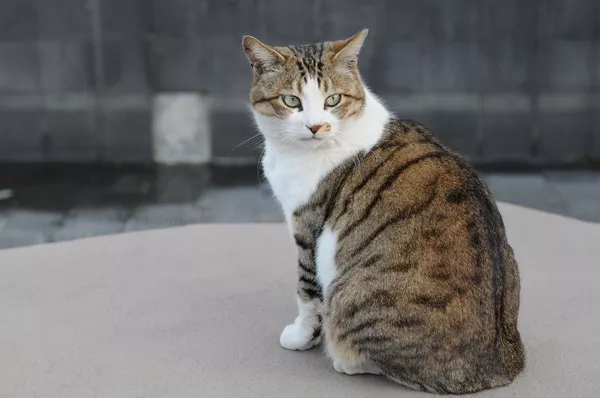Calico cats are a popular and distinctive type of cat known for their unique coat patterns of white, black, and orange. As a veterinarian, one of the questions I am frequently asked by cat owners is what types of calico cats are there.
Types of Calico Cats
Dilute Calico: Dilute calico cats have a lighter, more muted coat pattern than traditional calico cats. Their coat is typically a mix of white, gray, and cream, with patches of orange or black.
Tortoiseshell Calico: Tortoiseshell calico cats have a coat pattern that combines black and orange patches, with little to no white. Their coat can also include shades of brown, cream, and gray.
Caliby: Caliby cats, also known as calico tabbies, have a coat pattern that combines the calico colors with tabby stripes. Their coat is typically a mix of white, black, orange, and brown, with stripes of various thicknesses.
Calico Persian: Calico Persians have a long, thick coat that is typically a mix of white, black, and orange. Their coat requires regular grooming to prevent matting and keep it healthy.
Calico Maine Coon: Calico Maine Coons are large, muscular cats with a thick, shaggy coat. Their coat is typically a mix of white, black, and orange, with a distinctive “ruff” of fur around their neck.
Caring for Your Calico Cat
Regardless of the type of calico cat you have, it is important to provide them with proper care and attention to ensure that they stay healthy and happy. This can include regular veterinary check-ups, a healthy diet, and plenty of exercise and playtime. Calico cats are known for their independent and affectionate personalities, and enjoy spending time with their owners. They also require regular grooming to keep their coat healthy and prevent matting.Here are some tips for caring for your calico cat:
Regular veterinary check-ups: Like all cats, calico cats require regular veterinary check-ups to ensure they are healthy. This includes vaccinations, parasite prevention, and routine blood work to detect any potential health issues early on.
Healthy diet: A healthy diet is essential for maintaining your calico cat’s overall health. Feed them a high-quality, balanced diet that meets their nutritional needs, and avoid overfeeding to prevent obesity.
Exercise and playtime: Calico cats are active and playful, and require plenty of exercise and playtime to stay healthy and happy. Provide them with toys and scratching posts to keep them entertained, and spend time playing with them each day.
Grooming: Calico cats have a thick coat that requires regular grooming to prevent matting and keep it healthy. Brush their coat regularly to remove loose fur and prevent hairballs, and trim their nails to prevent overgrowth.
Attention and affection: Calico cats are known for their affectionate personalities, and enjoy spending time with their owners. Make sure to provide them with plenty of attention and affection, and create a comfortable and safe environment for them to relax in.
Genetics of Calico Cats
Calico cats are not a specific breed of cat, but rather a coat pattern that can occur in many different breeds. The unique coat pattern of calico cats is due to a genetic mutation that affects the distribution of pigments in the fur. This mutation is linked to the X chromosome, which means that calico cats are almost always female.
Male calico cats do exist, but they are extremely rare and are typically sterile. The genetics of calico cats can be complex, and potential owners may want to consult with a veterinarian or breeder to better understand the inheritance of this coat pattern.
Calico cats are almost always female: As you mentioned, the gene for calico coloring is linked to the X chromosome. Since females have two X chromosomes, they can inherit two different versions of the gene and express the calico pattern. Male cats, on the other hand, have only one X chromosome, so they can only inherit one version of the gene. This means that male calico cats are very rare, and typically have an extra X chromosome (XXY) or other chromosomal abnormalities.
The calico pattern is a result of random X chromosome inactivation: In female calico cats, one of the X chromosomes is randomly inactivated in each cell during development. This means that some cells express one version of the gene, while others express the other version. This results in the distinctive patchwork pattern of black, orange, and white fur.
The genetics of calico cats can be complex: While the basic inheritance of the calico pattern is linked to the X chromosome, there are other factors that can affect the expression of the gene. For example, some breeds may be more likely to produce calico cats than others, and environmental factors can also play a role in the expression of the calico pattern.
Behavioral Traits of Calico Cats
In addition to their distinctive coat patterns, calico cats are known for their unique behavioral traits. Calico cats are often described as independent, intelligent, and affectionate.
They enjoy spending time with their owners, but are also content to spend time alone. Calico cats are also known for their strong personalities, and may be more assertive or vocal than other types of cats. Potential owners should be prepared to provide plenty of mental and physical stimulation for their calico cat, as well as plenty of love and attention.
Conclusion
There are several different types of calico cats, each with their own unique coat patterns and characteristics. By learning about the different types of calico cats, potential owners can make an informed decision about bringing one of these cats into their home, and can provide them with the care and attention they need to thrive. Whether you have a dilute calico, tortoiseshell calico, caliby, calico Persian, or calico Maine Coon, your calico cat is sure to bring joy and companionship to your life.
Related Topics



























